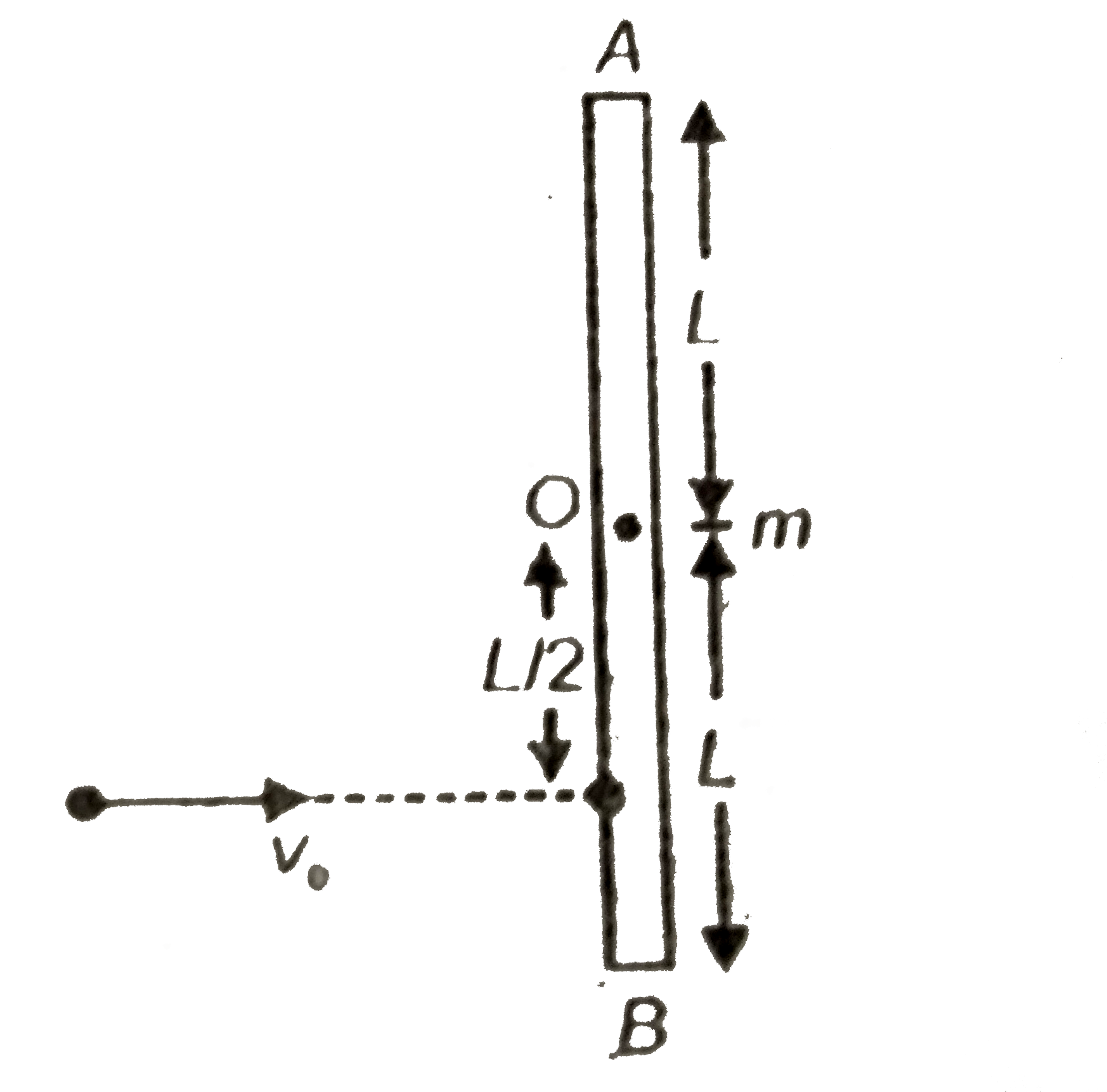Complete Solutions to Exercise-5 : Subjective Type Problems of chapter VECTOR & 3DIMENSIONAL GEOMETRY of Class 12 book with complete answers and questions
| Class 12 | MATHS |
| Chapter | VECTOR & 3DIMENSIONAL GEOMETRY |
| VIKAS GUPTA | Exercise-5 : Subjective Type Problems |
| Number Of Questions | 16 |
| Academic Year | 2023-24 |
A rod `AB` of length `2L` and mass `m` is lying on a horizontal frictionless surface. A particle of same mass `m` travelling along the surface hits the rod at distance `(L)/(2)` from `COM` with a velocity `v_(0)` in a direction perpendicular to rod and sticks to it.

Distance of point `P` on rod from `B` which is at rest immediately afte collision is07:30View SolutionIf `hata, hatb and hatc` are non-coplanar unti vectors such that `[hata hatb hatc]=[hatb xx hatc" "hatc xx hata" "hata xx hatb]`, then find the projection of `hatb+hatc` on `hata xx hatb` .
09:20View SolutionLet OABC be a tetrahedron whose edges are of unit length. If `vec OA = vec a` , `vec OB = vec b`, and `vec OC` = `alpha(vec a + vec b) + beta(vec a xx vec b), `then `(alpha beta)^2 = p/q`(where p & q are relatively prime to each other),then the value of `[q/(2p)]` is
11:00View SolutionIf A is the matrix `[(1,-3),(-1,1)]`, then `A-(1)/(3)A^(2)+(1)/(9)A^(3)……….. +(-(1)/(3))^(n)A^(n+1)+ ……… oo=(3)/(13)[(1,a), (b,1)]`. Find `|(a)/(b)|`.
08:15View SolutionA sequence of `2xx2` matrices `{M_(n)}` is defined as follows `M_(n)=[((1)/((2n+1)!),(1)/((2n+2)!)),(sum_(k=0)^(n)((2n+2)!)/((2k+2)!), sum_(k=0)^(n)((2n+1)!)/((2k+1)!))]` then `lim_(n to oo) "det". (M_(n))=lambda-e^(-1)`. Find `lambda`.
05:28View SolutionLet `|veca|=1, |vecb|=1 and |veca+vecb|=sqrt(3)`. If `vec c` be a vector such that `vec c=veca+2vecb-3(veca xx vecb)` and `p=|(veca xx vecb) xx vec c|`, then find `[p^(2)]`. (where [ ] represents greatest integer function).
06:56View SolutionLet `vecr=(veca xx vecb)sinx+(vecb xx vec c)cosy+2(vec c xx vec a)`, where `veca, vecb, vec c` are non-zero and non-coplanar vectors. If `vecr` is orthogonal to `veca+vecb+vec c`, then find the minimum value of `(4)/(pi^(2))(x^(2)+y^(2))`.
09:34View SolutionThe plane denoted by `P_1 : 4x+7y+4z+81=0` is rotated through a right angle about its line of intersection with plane `P_2 : 5x+3y+10z=25`. If the plane in its new position be denoted by P, and the distance of this plane from the origin is d, then the value of `[(k)/(2)]` (where[.] represents greatest integer less than or equal to k) is....
05:47View SolutionABCD is a regular tetrahedron, A is the origin and B lies on x-axis. ABC lies in the xy-plane `|vec(AB)|=2` Under these conditions, the number of possible tetrahedrons is :
04:57View SolutionA, B, C, D are four points in the space and satisfy `|vec(AB)|=3, |vec(BC)|=7, |vec(CD)|=11 and |vec(DA)|=9`. Then find the value of `vec(AC)*vec(BD)`.
07:12View SolutionLet OABC be a regular tetrahedron of edge length unity. Its volume be V and `6V =sqrt(p/q)` where p and q are relatively prime. The find the value of `(p+q)`.
02:03View SolutionIf `veca and vecb` are non zero, non collinear vectors and `veca_(1)=lambda veca+3 vecb, vecb_(1)=2veca+lambda vecb, vec c_(1)=veca+vecb`. Find the sum of all possible real values of `lambda` so that points `A_(1), B_(1), C_(1)` whose position vectors are `veca_(1), vecb_(1), vec c_(1)` respectively are collinear is equal to.
05:27View SolutionLet P and Q are two points on the curve `y=log_((1)/(2))(x-0.5)+log_2sqrt(4x^(2)-4x+1)` and P is also on the circle `x^(2)+y^(2)=10`. Q lies inside the given circle such that its abscissa is an integer.
Q. `OP*OQ`, O being the origin is03:45View SolutionLet P and Q are two points on the curve `y=log_((1)/(2))(x-0.5)+log_2sqrt(4x^(2)-4x+1)` and P is also on the circle `x^(2)+y^(2)=10`. Q lies inside the given circle such that its abscissa is an integer.
Q. The coordinates of P are given by02:01View SolutionIf `a, b, c, l, m, n in R-{0}` such that `al+bm+cn=0, bl+cm+an=0, cl+am+bn=0`. If a, b, c are distinct and `f(x)=ax^(3)+bx^(2)+cx+2`. Find f(1) .
06:24View SolutionLet ` vec ua n d vec v` be unit vectors such that ` vec uxx vec v+ vec u= vec w` and ` vec wxx vec u= vec vdot` Find the value of `[ vec u vec v vec w]dot`
05:13View Solution
Exercise-5 : Subjective Type Problems questions and complete solutions for chapter VECTOR & 3DIMENSIONAL GEOMETRY of SHRI BALAJI MATHS (ENGLISH) of Class 12
